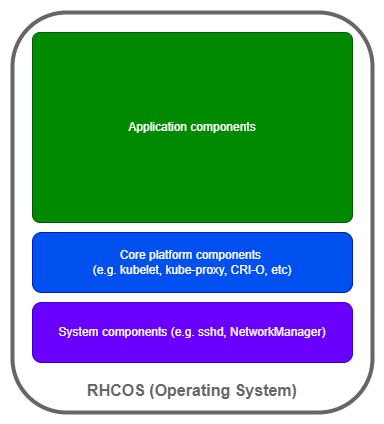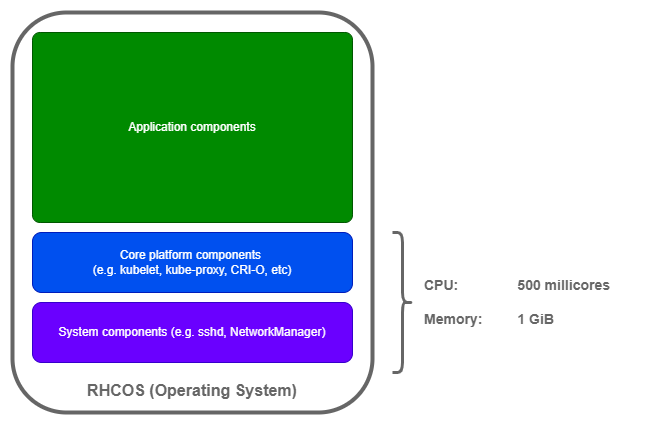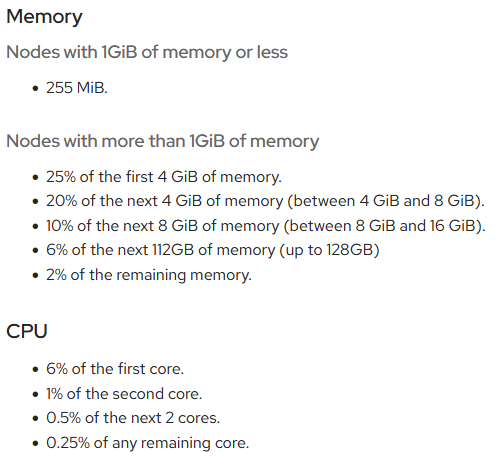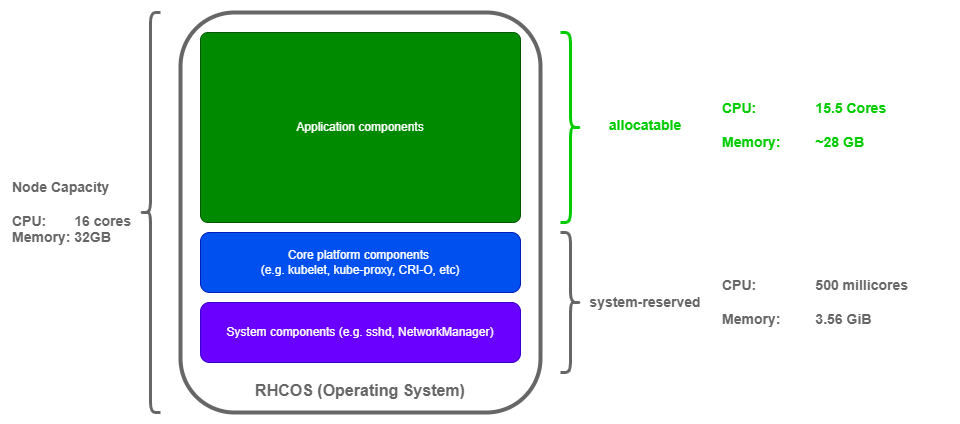Node Sizing
Ever wondered why your application running on your Kubernetes or OpenShift cluster appears to run slowly or less performant than expected? Or perhaps your cluster is experiencing one of the following, but you can't understand why?
- Out-of-Memory (OOM) events both at the application and core platform layers.
- Higher than normal Pod evictions or throttling.
- General node instability.
This article is intended to help you build a stable OpenShift platform for your AIOps deployment. It is meant to provide enough knowledge of the basics to plan clusters for AIOps, not as a deep technical dive into Red Hat CoreOS and core components.
By the end of this guide, you will have good basic understanding of:
- the importance of system reservations for CPU and memory on a node.
- what happens when the core, foundational platform (i.e. the node) suffers from resource starvation, and what it means for your AIOps deployment.
- how to calculate OpenShift node system reservations.
- how to configure adequate system reservations for your cluster nodes.
This guide focuses on OpenShift, however the same concepts apply to Kubernetes in general:
- See Reserve compute resources for more details.
Why is this important?
Let's start with an analogy.
Think about building a house. It is common to dream about:
- what you want your decor in a room to look like.
- what sofas or furniture you want to place, and where.
- what fixtures you want to hang from or secure onto your walls.
Before you purchase your furniture or fixtures, have you planned for and ensured:
- your joists supporting your floors have been adequately specified and spaced by a structural engineer to guarantee they can take the weight of your furniture?
- your foundation has been laid to the right depth, thickness and cement mixture ratio to achieve the desired strength for holding up your house?
So, you purchased a luxury steel bathtub, but your builder spaced out your floor joists too far apart to achieve the required strength to support your bathtub.
Before you know it, your bathtub has fallen through the floor and is now sitting in the middle of your living area.
Probably not where you intended it to be right?
(No house, person or animal was hurt in the making of this analogy).
One of the most overlooked aspects of any deployment is ensuring the base Operating System or platform has the necessary resources for its core components to function properly. Building a stable and performant foundation for applications to run on. Avoiding resource starvation at a base level, which could bring down your application.
Anatomy of a node
So, what exactly is a node made up of?

As you can see, there is more running on the node beyond the application(s).
These core platform and system components, let's call them core components, are the forgotten heroes of a cluster, working diligently in the background to ensure your cluster supports your applications.
Just like any other software components, they require system resources to operate efficiently. By default, OpenShift reserves the following system resources for these core components:

What is often overlooked is, there is a relationship between how much CPU and memory your node has been provisioned with AND how much of those resources should be reserved relative to the overall capacity for these core components.
Generally speaking, the bigger and more powerful your car, the bigger your car engine. Therefore, the more fuel it will use in comparison to a smaller, less powerful car.
The engine is fundamentally what is transforming your fuel into energy to power your car. If it does not receive enough fuel relative to its energy conversion expectations, your car will underperform and eventually stop.
The core components are like the engine of your node. If there is an imbalance between the capacity of the node and how much relative resource is reserved for the core components, your node, therefore your application underperforms.
How does this affect Pod scheduling?
The scheduler is a process running on the cluster's control plane which is responsible for assigning Pods to Nodes.
Full details of how the scheduler works is out of scope for this guide.
As per the OpenShift documentation:
The scheduler uses the value of
node.Status.Allocatableinstead ofnode.Status.Capacityto decide if a node will become a candidate for Pod scheduling.By default, the node will report its machine capacity as fully schedulable by the cluster.
So, if the node is reporting that all its capacity is available, how does the scheduler really know how much of the node's capacity is available for Pod allocation?
It
calculates
it based on other parameters, including system-reserved values, then compares
it against any Pod requests:
- Note:
kube-reservedis not used directly in OpenShift, the values for core Kubernetes components is added into thesystem-reservedvalues.- See Understanding eviction thresholds for more information on that element.
Once it understands what is allocatable, it further filters nodes based on criteria such as resource utilization (basically how many other Pods are utilizing the node's allocatable resources already), affinity rules, etc.
Key scheduling takeaway
If the values for system-reserved are not updated in line with how much CPU
and memory you allocate to a node, this calculation is skewed, resulting in many
downstream performance or instability issues.
Since many different symptoms can be experienced as a result of this type of core component resource starvation, most teams enter into a continuous reactive cycle. Tackling symptoms without resolving the root cause of the issues.
Understanding this core element of node sizing helps alleviate and deflect many downstream issues in your cluster, including perceived application-level issues.
How do I calculate what to reserve for core components?
The formula for how system reserves are calculated in OpenShift are documented in a knowledge article, captured here for convenience:

Example
If we consider a node with 16 CPU cores and 32 GB RAM, how much node capacity is really available for AIOps (or other application) Pods?

There are a few things to note in this example:
- Allocatable memory is shown in
GB, having subtracted the convertedsystem-reservedmemory fromGiB. - The
system-reservedCPU based on the formula would actually be110 millicores, however since that is below the default, I've left the default value in place. More on that later.
Each node actually has 15.5 cores and ~28GB RAM allocatable for AIOps,
having ensured enough relative resources are reserved for the core components.
So how many nodes do I really need for my application?
When you size your applications in terms of CPU and RAM requirements and try to calculate how many nodes you need to support your application, don't forget to calculate node count based on what is allocatable on each node, not total capacity.
Otherwise, your deployment will suffer performance and instability issues.
How do I update node system-reserved settings?
There are 2 options:
Both procedures are very well documented in the OpenShift documentation so I won't repeat them here.
In essence they involve a 2-step process:
- Edit the
machineconfigpoolfor the type of node you want to update and labels for node selection. - Create a custom resource (CR) with your configuration change.
SWAT Recommendations
-
Regardless of which update method you select (manual or automatic), it is highly advisable to understand the calculations, reasons and impact of
system-reservedvalues in relation to your node profiles and cluster requirements:- Do the calculation manually anyway as it is crucial during any planning phase so you know how much resource you really need for your use case(s).
- Understand what the impact would be of updating values post application deployment.
-
If your calculations show a value fall below the default, to be on the safe, stick with the default value:
- It may be tempting to squeeze resources further, however going below the defaults may be counterproductive.
-
Calculate node count based on:
- Allocatable resources per node.
- Plan for additional 2-3 nodes and related resources such as IP addresses for OpenShift and software updates.
-
If you are deploying a new cluster from scratch, then automatic resource allocation for core system components is advised.
-
If you are updating an existing cluster, especially in production, then we would recommend:
- Perform the calculations to understand if your current cluster capacity is really enough for your workload.
- Plan to add compute capacity based on allocatable numbers and node counts.
- Perform a manual canary rollout of changes to observe behaviour in a safe manner.
- Complete node updates once things stabilize.
- Update any automation or GitOps configuration for your nodes to use automatic reservation updates for future rollouts.
Conclusion
So hopefully now you have a better understanding of what really happens on a compute node, and why you might be experiencing performance or instability symptoms in your cluster or application.
Ensuring your node's core components are adequately resourced in relation to your node profile, and not being starved by application Pods incorrectly being scheduled onto a node, is critical to ensuring application and cluster performance and stability.
Check your clusters today and plan updates to configuration accordingly.